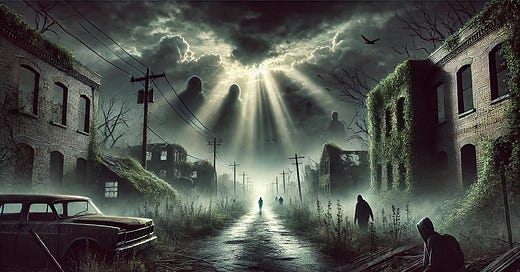I’ve been stuck this week, nothing done. No writing, no deep dives into AI, and it’s all Stephen King’s fault.
So what happened? I have an Audible account, and I still have several credits. I was re-listening to another podcast, or perhaps it was that ‘autobiography’ of Mr. King’s On Writing; I’m honestly not sure. But it started me thinking about The Stand by Stephen King. A book I’ve been meaning to read for some time, just to see what all the fuss was about. Then, the fatal mistake.
The Stand
The extended version appeared in my weekly Audible newsletter, so I spent one of my credits on it. The extended audiobook version runs for over 47 hours, and I’ve been thoroughly hooked from the start. Nothing else matters—not the day job, this newsletter, the new Substack publication I’m working on, or even family. The last week has been all about The Stand.
I had planned to do so much this last week, but now everything is well behind schedule. The worst thing is (or is that the best thing?) I still have over 6 hours to go, and I have to get it out of my system today before the start of the new week. So, my apologies if you were expecting another typical newsletter from me. Instead, I’m focussing on fictional characters and how they sometimes get right under our skin.
The only positive that’s come out of this (apart from thoroughly enjoying the book) is the importance of character-building in fiction. Listening to The Stand, I have little idea what most characters look like physically. Yes, there are a few scatterings of description here and there, but they’re glossed over and are completely unimportant for the story. We can see how a character comes alive in our minds, not through physical characteristics but by encouraging us to create them however our subconscious sees fit.
Why Less is More
When writing fiction, the truism ‘less is more’ is never more evident than when introducing the protagonists and antagonists. The less we describe them, the more our minds fill in the blanks, so the personal connection between them and us becomes much more profound.
So, what does this tell us? Stephen King masterfully introduces each character in The Stand; a brief physical description is enough. But what follows embeds the characters in the story and our minds. Taking it slow, King builds them up one small piece at a time, allowing us to integrate each characteristic into our imagination. Before very long, we develop strong emotional connections with them. We care what happens to them and hope they make it to the end, or not in the car of the antagonists.
Thinking back to my book, I see that I am including far too much detail, leaving less room for readers to fill out the characters for themselves. I’m not going to rewrite these chapters just yet, though. I feel that, at least for this first novel, I had better complete the first draft. God knows when I’ll get there, but I’ll keep plugging away whenever I can.
Spoiler Alert
If you’ve read or listened to On Writing, you will know that Stephen King became thoroughly stuck at a critical point in the book. Several weeks passed, and he was almost despairing about how to continue the story, and he was terrified that his several hundred thousand word manuscript might have to be trashed. That was until, one day, on his daily walk, King had the epiphany he had been searching for, hoping for.
A simple explosive device hidden in a closet was all he needed to move the story into its final stages. As I approached this part of the book, I became worried that some of my favorite characters would become victims. I even considered stopping listening or skipping to the end, just so I wouldn’t have to experience the tragic ending. I listened on.
As I awoke this cold and cloudy Sunday morning, I finally began to think about writing this post and hadn’t got a clue what I would write about. I needn’t have worried; listening to The Stand audiobook gave me everything I needed. When I sat down at my desk, I got to thinking about how character development is, maybe, the most essential aspect of any story. The reader must empathize with the characters in a very personal way. While plot and setting are also high on the priority list of what makes a good story, the characters make it all possible.
Final Thoughts
I’ve kept this week’s newsletter short and to the point. This isn’t because I have nothing more to say on the subjects covered (I have a lot of things whirling about in my head right now), but because I want to return to The Stand, where things are rapidly coming to a climactic end.
I’m almost finished with the 68th of the 78 chapters, with just five hours to go. I need to get back to it. I’m driven to do so. It’s a compulsion, an itch that I have to scratch.





